Trek Week, Part 3
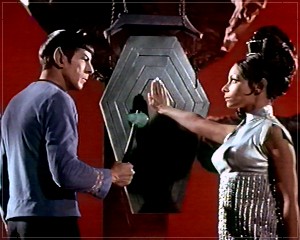 I was so inspired by Star Trek Continues that I decided to dedicate the week of my birthday to talking about my first great fictional love, the original Star Trek. Today I’ll start rambling about all the things I’ve always wanted to do if I got to be the executive story editor of a rebooted Star Trek TV show. Yeah, I know, it’s pretty self indulgent, and I’m ashamed to say I’ve spent way too much time over the years thinking about this. But my birthday’s coming up, so you’ll forgive me, right?
I was so inspired by Star Trek Continues that I decided to dedicate the week of my birthday to talking about my first great fictional love, the original Star Trek. Today I’ll start rambling about all the things I’ve always wanted to do if I got to be the executive story editor of a rebooted Star Trek TV show. Yeah, I know, it’s pretty self indulgent, and I’m ashamed to say I’ve spent way too much time over the years thinking about this. But my birthday’s coming up, so you’ll forgive me, right?
I think I should make a certain mindset absolutely clear as I go forward. Canon cannot be a stumbling block. Star Trek canon itself is inconsistent. (For example, it was Vulcanian before it was Vulcan and Starbases used to be called Earth Bases.) Even details from really good episodes can be problematic — for instance, could the space battle that happens a century before the start of “Balance of Terror” really have taken place using only sublight vessels? Wouldn’t those ships have had to leave Earth a few thousand years before now to get there in time to fight the Romulans?
All these things and many more present canon problems, but nothing so much as the behavior of the characters themselves. Which is the real Uhura — the one who bravely sasses Sulu in “The Naked Time” or the one who frequently tells Kirk “I’m frightened?” How do we reconcile the deep, complex, nuanced characters in “Amok Time” with the idiots we see in episodes like “And the Children Shall Lead” and “Plato’s Stepchildren?” In those clunker shows the characters don’t even talk much like themselves, no matter that the familiar actors are playing them.
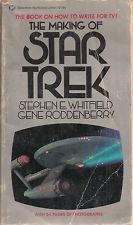 Anyone rebooting the original Star Trek as a TV series has to be able to free themselves of the idea that everything the series showed us has to happen. What must remain fundamentally the same, however, are the characters. To be Star Trek, the crew has to consist of the same people we saw in the best moments of the series. Of course all the Star Trek universe’s underpinnings should be the same — Federation, Klingons, transporters, the Enterprise out on the edge of explored space, etc. Nothing matters quite as much, though, as the characters and the feel. If you don’t get the characters and the feel right, you don’t have the real Star Trek, no matter how big your budget. (I’ll be talking about the characters later, and I’ll add that anyone truly serious about rebooting Star Trek should read Stephen Whitfield’s excellent The Making of Star Trek for its lengthy discussion of them.)
Anyone rebooting the original Star Trek as a TV series has to be able to free themselves of the idea that everything the series showed us has to happen. What must remain fundamentally the same, however, are the characters. To be Star Trek, the crew has to consist of the same people we saw in the best moments of the series. Of course all the Star Trek universe’s underpinnings should be the same — Federation, Klingons, transporters, the Enterprise out on the edge of explored space, etc. Nothing matters quite as much, though, as the characters and the feel. If you don’t get the characters and the feel right, you don’t have the real Star Trek, no matter how big your budget. (I’ll be talking about the characters later, and I’ll add that anyone truly serious about rebooting Star Trek should read Stephen Whitfield’s excellent The Making of Star Trek for its lengthy discussion of them.)
But as to that feel – no one has ever described it so well as Torie Atkinson in an essay she wrote after viewing the first season of Star Trek for the very first time. I’ve read many a fine essay about the power of Star Trek over the years, but no one has ever conveyed it as well as Ms. Atkinson. I’ll excerpt part of it here, and then you should drop by the site and read the entire thing (click on the text below to get there). Anyone involved in a Star Trek TV reboot should read and re-read this essay and thoroughly understand it. Hell, anyone involved in a Trek reboot should make sure to ask Torie Atkinson on board to assist the effort.
Alright, you back with me? Great. Now let’s get to the nitty gritty.
What people who are removed from Star Trek (say, movie producers) never seem to get is that most fans don’t like Trek because of the cheesy styrofoam boulders or the now dated special effects. We like it in spite of those things. We don’t want them anymore. We may smile fondly at the fact Kirk so often romances the pretty guest stars, or smirk that hey, look, another red shirt’s about to die, or, hey, Kirk’s going to out-logic another computer or stop another villain with a fist fight, but that’s just because we love our show, warts and all. Those aspects are not why we tuned in. Those artifacts from the ‘60s don’t need to remain.
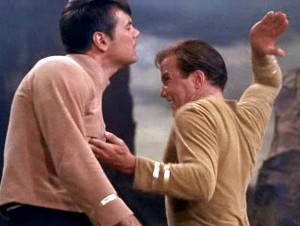 The fistfight at the end? That’s because the original network executives didn’t like the first show pilot because it was too cerebral. Gene Roddenberry made sure the second show pilot ended with a western style brawl to please them, and he kept it up. The death of security guards? A shortcut to let us know that matters in the story had gotten serious, one that got to be lazy shorthand. The Kirk romances? Another ‘60s artifact because it was thought the leading man always needed to be showing his prowess with the ladies. Sure, Kirk has an eye for the ladies, but he doesn’t need to have a romance every episode. In the first season those moments were more rare, and Kirk sometimes used his manly powers not because he was interested, but to save the ship. By the second season the Kirk lovin’ had gotten sloppy and far too frequent. We’d have to cut way back on that.
The fistfight at the end? That’s because the original network executives didn’t like the first show pilot because it was too cerebral. Gene Roddenberry made sure the second show pilot ended with a western style brawl to please them, and he kept it up. The death of security guards? A shortcut to let us know that matters in the story had gotten serious, one that got to be lazy shorthand. The Kirk romances? Another ‘60s artifact because it was thought the leading man always needed to be showing his prowess with the ladies. Sure, Kirk has an eye for the ladies, but he doesn’t need to have a romance every episode. In the first season those moments were more rare, and Kirk sometimes used his manly powers not because he was interested, but to save the ship. By the second season the Kirk lovin’ had gotten sloppy and far too frequent. We’d have to cut way back on that.
Naturally the sexism would have to go. For the time, the women on the show seemed pretty liberated – they had respected positions among the men and clearly had responsibilities. Now it’s obvious that the men on the ship still had all the important posts. This would have to change.
There’s no way you could possibly alter the sex of any of the main characters, as was done on the Galactica reboot. All fans, me among them, would be up in arms.
 Instead you’d have to shore up the parts of both Lt. Uhura and Nurse Chapel, and possibly bring back Yeoman Rand, although her role was really just for eye candy, as even the original series bible seems to suggest. Uhura, according to the series bible, was pretty high up on the chain of command. If Kirk and Spock are away on a mission or off duty then by God, she should have the conn.
Instead you’d have to shore up the parts of both Lt. Uhura and Nurse Chapel, and possibly bring back Yeoman Rand, although her role was really just for eye candy, as even the original series bible seems to suggest. Uhura, according to the series bible, was pretty high up on the chain of command. If Kirk and Spock are away on a mission or off duty then by God, she should have the conn.
As with both pilot episodes, female uniforms could be either some kind of dress or slacks so that it wouldn’t look like the women were required to don sexywear to serve on the ship. (I do realize that women of the time found them liberating. Young women from my son’s generation don’t get that, and see the skirts as signs of sexism.) But I’d suggest one other change. Add another important female character. Who, you ask?
Apart from one first season episodes, where Lt. Commander Gioto makes an appearance, we never see nor hear from a chief of security. And it seems like that security perspective would have been necessary on board a starship. Add a female head of ship’s security, preferably one of Indian or Arabian descent. She wouldn’t be firing the ship’s weapons (wouldn’t we all miss Sulu firing those?) but she’d be involved in all away teams and the ship’s security issues that always crop up, and be there for all the briefing room meetings. Perhaps she could be the one raising and lowering the deflector screens and have a bridge position, as the security chief on the fan-produced Exeter starship episode was doing.
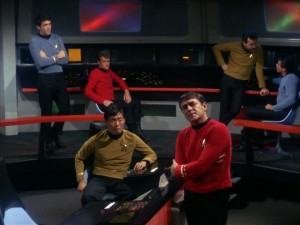 Let’s take a look at sexuality. The ‘60s Star Trek was all about inclusiveness and our essential humanity, be a character Asian, black, Vulcan, or even a Ruskie. Today it’s time there was a major gay character. The cheap out would be to create an all-new homosexual character, say, Lt. Gaybob, Chief of Geology. And that would be really, really lame. Homosexuality should be just an aspect of a character rather than a defining characteristic. Like, you know, a real person. I can hear you saying, oh, okay, so then how about we make this new character you propose, this security chief, a lesbian?
Let’s take a look at sexuality. The ‘60s Star Trek was all about inclusiveness and our essential humanity, be a character Asian, black, Vulcan, or even a Ruskie. Today it’s time there was a major gay character. The cheap out would be to create an all-new homosexual character, say, Lt. Gaybob, Chief of Geology. And that would be really, really lame. Homosexuality should be just an aspect of a character rather than a defining characteristic. Like, you know, a real person. I can hear you saying, oh, okay, so then how about we make this new character you propose, this security chief, a lesbian?
But I’d say that’s still a cop-out. (Men are more comfortable with the concept of gay women than gay men, and if a security chief is a lesbian, aren’t you subtly suggesting that you have to be “mannish” to be a capable warrior? Let’s not even go there.) I’d argue for changing the perceived sexuality of one of the tried and true characters. And no, not Sulu. Just because he was played by a homosexual man doesn’t mean the character is gay. George Takei himself has said Mr. Sulu is not gay. As a matter of fact, making Sulu gay because Takei has come out is just as insulting as inventing Lt. Gaybob the geologist.
No, I’d say it would be better if either Chekov, Scotty, or McCoy were homosexual. Sure, each of them had some episodes (mostly pretty weak ones) where their character was in a romantic relationship with a woman, but is the sexuality of any of those characters their defining characteristic? Nope. I don’t think changing their sexuality would matter in the least to any story or their characters so long as you keep the series feel — meaning no romantic tension between the character and the other primary and secondary characters on the ship. That kind of unrecquited romance would play right to the fear some straight men seem to have that gay men probably want to hit on them. Believe it or not, it’s possible to be straight and have a close friend who’s gay. Really.
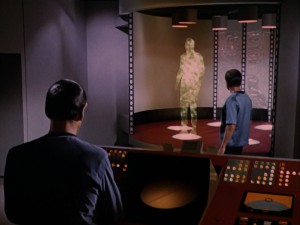 Speaking of transformative changes, the transporter was a pretty cool special effect. I honestly think the old gold sparkle still looks better than all the fancy new improved versions we’ve seen over the years. It was much cheaper to beam people around than to show the ship landing on a planet each week, or to depict a bunch of involved docking procedures. The problem was that when the stuff hit the fan, Kirk and the landing party could just get the hell out of there, problem solved, no worries… and no tension. Thus the writing staff had to do some quick tap dancing and provide limitations.
Speaking of transformative changes, the transporter was a pretty cool special effect. I honestly think the old gold sparkle still looks better than all the fancy new improved versions we’ve seen over the years. It was much cheaper to beam people around than to show the ship landing on a planet each week, or to depict a bunch of involved docking procedures. The problem was that when the stuff hit the fan, Kirk and the landing party could just get the hell out of there, problem solved, no worries… and no tension. Thus the writing staff had to do some quick tap dancing and provide limitations.
First, the transporter would take a while to lock on and you had to stand still. So, no beaming in the midst of a chase situation. Second, you couldn’t beam things in or out when the ship’s deflector screens were on, which is why you couldn’t simply lock onto your enemies as you were getting ready for a fight and beam ‘em into space (problem solved, again, too easily). Also, the Enterprise had to be in a tight orbit to actually be close enough to beam people around.
If you don’t keep all of these limitations in mind (and be ready with others as needed, for example, ion storms a la “Mirror, Mirror”), then you end up with all kinds of story problems, which is why my mind was seriously boggled when, in the first reboot movie, the crew was beaming not only halfway across the solar system,but across vast interstellar distances. The transporter is difficult enough to use and still maintain plot tension. If you make it capable of beaming wherever, whenever, your writers are quickly going to run into problems down the line. Let’s keep the transporter the way it used to be, save that it should be clear that there’s more than one transporter room (there are probably several scattered through the ship, as various blueprints have suggested over the years).
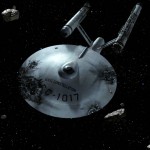 As for the look of the ship — well, it would obviously have to be updated and given chairs that don’t fall over, but I think the basic floorplan should remain — really, it’s an excellent bridge design except for the fact it seems to be at the top of the ship, for no good reason. Any changes made to ship or uniform would have to be well considered. Updated, but reminiscent.
As for the look of the ship — well, it would obviously have to be updated and given chairs that don’t fall over, but I think the basic floorplan should remain — really, it’s an excellent bridge design except for the fact it seems to be at the top of the ship, for no good reason. Any changes made to ship or uniform would have to be well considered. Updated, but reminiscent.
Tomorrow I’ll start talking about updating the characters.
8 Comments